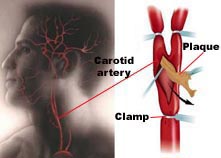

 |  |
MAY IS NATIONAL STROKE AWARENESS MONTH
It's a good time to learn about the carotid endarterectomy operation for stroke prevention

![]() Carotid endarterectomy {keh-RAHT-id end-ahr-tur-EK-tuh-me} is
a vascular operation in which the surgeon removes an obstruction in the
carotid (neck) artery caused by hardening of the arteries (atherosclerosis).
This operation is performed to prevent stroke.
Carotid endarterectomy {keh-RAHT-id end-ahr-tur-EK-tuh-me} is
a vascular operation in which the surgeon removes an obstruction in the
carotid (neck) artery caused by hardening of the arteries (atherosclerosis).
This operation is performed to prevent stroke.
The most common vascular surgery performed in the United States today, carotid endarterectomy is proving more successful than ever in preventing stroke, significantly reducing the risk of it.
In fact, with carotid endarterectomy the risk of stroke can be reduced by three to four times in patients who have symptoms and cut in half in symptom-free patients with lesser risk.
As we age, our arteries narrow. They lose their flexibility and the linings thicken. When the arteries in the neck begin to narrow, blood clots may develop. The carotid artery may become completely blocked or a piece of clot may break off and travel to the brain. In both cases a stroke also known as "brain attack" may result.
Risk of stroke increases as the artery becomes more and more narrow. The risk is particularly high after the artery is blocked more than 70%. The amount of blockage may be determined by a simple painless test called a Carotid Doppler or Carotid Ultrasound.
People at greatest risk for carotid artery narrowing are those over age 65 (particularly smokers) and those who already have poor circulation in the legs or their heart. Patients who have temporary loss of vision or speech and/or weakening of an arm or leg may have had a "mini-stroke" and should see their doctor.
Carotid endarterectomy by an experienced surgeon is a very effective way to reduce the risk of stroke. People who are considering carotid endarterectomy should ask their potential surgeon about his/her experience and results. In general, the chance of complication occurring during surgery should be minimal in the average patient.
Carotid disease is only one of several types of hardening of the arteries. Our surgeons perform a broad range of operations, in addition to carotid endarterectomy, to correct arterial problems.
In selected cases, a newly developed minimally-invasive procedure called carotid angioplasty, or stenting, is an option. This procedure involves using a balloon-like device to open a clogged carotid artery and placing a small wire tube (stent) into the artery to keep it open.
Dr. Enrique Criado is board certified in vascular surgery, with extensive experience in conventional and minimally-invasive operations. He is chief of vascular surgery, and is skilled at both carotid endarterectomy and angioplasty. Dr. Criado sees patients in our University Hospital office. For appointments/consultations, call 631-444-2565.
Dr. Antonios P. Gasparis is board certified in surgery, with expertise in conventional and minimally-invasive techniques of vascular surgery, including the treatment of carotid disease. Dr. Gasparis sees patients in our East Setauket office. For appointments/consultations, call 631-444-4545.
Dr. John J. Ricotta is board certified in vascular surgery, with extensive experience in conventional and minimally-invasive operations. He is nationally renown for his work advancing surgery for stroke prevention. Dr. Ricotta sees patients in our University Hospital office. For appointments/consultations, call 631-444-2565.
